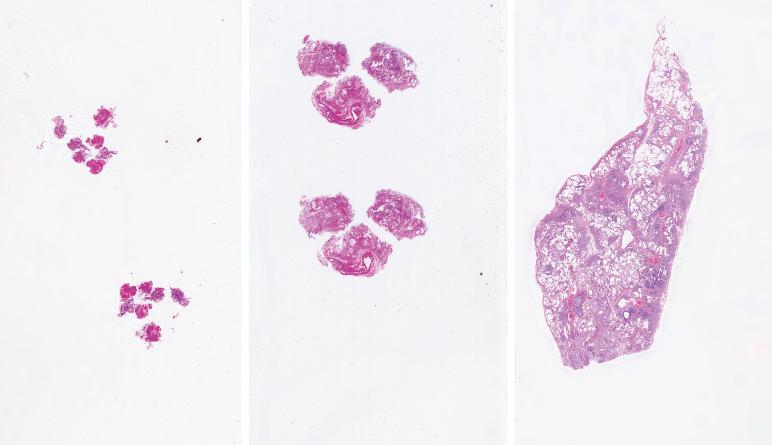Physical Address
304 North Cardinal St.
Dorchester Center, MA 02124
The lung biopsy is widely recognized as a valuable tool for the diagnosis and management of diverse pulmonary disorders. The various procedures currently in use, such as the open lung biopsy (OLBx), video-assisted thorascopic surgery (VATS) biopsy, and transbronchial lung biopsy (TBBx) and cryobiopsy (TBLC), can be diagnostic when performed under appropriate circumstances and if evaluated by the pathologist with several caveats in mind. Although the morphologic findings seen in lung biopsy specimens may represent a specific disease entity, in many circumstances these changes may be nonspecific findings that will need to be correlated with the clinical and radiographic presentations.
The lung biopsy is a relatively new tool for the diagnosis of lung diseases. Although rigid bronchoscopy was introduced just before the end of the 19th century, it was primarily used for visualization of the large airways without pathologic confirmation. Later refinements in procedures led to its use for the evaluation of central lesions, but peripheral lesions were poorly visualized and seldom biopsied.
In the early 1960s, refinements in optical technology led to the first flexible fiber-optic bronchoscope. The introduction of this new equipment and its application in a variety of clinical situations led to increased use of the TBBx. Henceforth, numerous studies examined the role of fiber-optic bronchoscopy and the diagnostic yield of TBBx in a spectrum of clinical settings.
In the past decade, TBLC offers another novel technique for obtaining larger tissue volumes than the conventional TBBx ( Fig. 2.1 ). During the bronchoscopic procedure, a cryoprobe rapidly freezes lung tissue samples, which are further processed as other biopsies. The TBLC provides more tissue that allows for better evaluation of lung parenchyma, small bronchioles, and blood vessels and may prove to be useful in various clinical settings. However, its current use is limited to very few centers, and its potential for more widespread use remains uncertain.

After World War II, major advances in surgical technique, anesthesia, and antibiotic therapy led to the development of the OLBx. Although this procedure is valuable for enabling diagnosis of many lung diseases, thoracotomy with OLBx is associated with significant morbidity and mortality. This procedure has now been largely replaced by VATS, which allows the thoracic surgeon to procure tissue via a less invasive means and potentially minimize postoperative complications. In capable hands, several studies have shown that the ability to procure tissue via VATS is equivalent to that of open thoracotomy. It is currently the standard of practice for obtaining lung tissue for the evaluation of interstitial lung diseases, primary lung cancer, and other mass lesions.
Become a Clinical Tree membership for Full access and enjoy Unlimited articles
If you are a member. Log in here